You are using an out of date browser. It may not display this or other websites correctly.
You should upgrade or use an alternative browser.
You should upgrade or use an alternative browser.
fire starter
Well-known member
fire starter
Well-known member
Summary, footage and good info in this video:
=================================
Article on one of the machines developed:
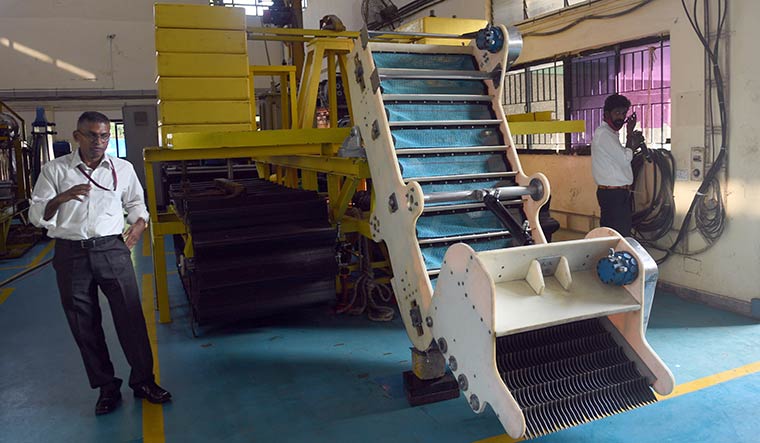
 www.theweek.in
www.theweek.in
It looks like a cross between a battle tank, a road construction machine and an animal, with its caterpillar tread, an elephantine trunk to pick up nodules, an assortment of plates and teeth to sort and grind them, and another contraption to pump up this harvest. In the looks department, it is certainly not in the league of a Formula One race car. Cdr Gopakumar N., however, is mighty proud of his strange-looking vehicle Varaha-1—named after the boar avatar of Vishnu.
Designed and developed by a small but inspired team of scientists at the National Institute of Ocean Technology (NIOT), Varaha-1 is a self-propelled seabed mining machine for the collection of polymetallic nodules (PMN). Unlike Matsya 6000, this one will not have any passengers. Its work is restricted to the collection and pumping of nodules, steadily and continuously over prolonged durations, in the deep-sea conditions up to 6,000m.
Upheavals on the ocean surface have minimal impact at depths of 3,000m and beyond, but there are other upheavals in the seabed. Hydrothermal vent activity at the tectonic plate boundaries and the back-arc basins form mineral-laden subsea geysers. Formed over millions of years, these accrete into subsea mounts and mineral deposits, providing polymetallic sulphides (PMS). Similarly, small rock-like nodules are formed over millions of years on the abyssal plains of the oceans. Mineral precipitation from the water accretes around the bones, shark teeth or rock fossils that descend to the seabed. Over millions of years, these become PMN—clods varying in size from a small grape to a large potato—rich in ferromanganese and the three critical metals of nickel, cobalt and copper. This is the treasure that Varaha-1 is preparing to harvest.
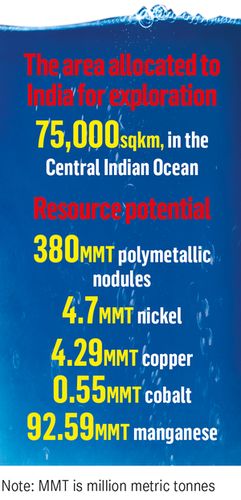
Net-zero is the new mantra. Experts forecast a spurt in electric vehicles (EVs), replacing fossil-fuel driven vehicles, over the next two decades. The known supplies of nickel, copper, and particularly, cobalt on land—key components in the batteries of EVs—are not adequate to meet these growing needs. Hence, the exploration for alternate supply sources. While space scientists are training their eyes on asteroid mining, oceanologists are looking at sustainable ways to commercially mine minerals from the ocean. PMNs are that manna, if only they can be brought up to the surface at commercially viable rates. Developing technology for deep-sea mining is an important project under the government’s deep ocean mission.
The open seas do not belong to any one country; their use is governed by several international bodies. Several countries and large business consortiums have staked prospecting areas of the ocean bed from the International Seabed Authority (ISA). Most of them are concentrated in the Pacific Ocean, in an area called the Clarion-Clipperton Zone, which has PMN in mineable proportions and is rich in cobalt and nickel. India was accepted as a pioneer investor by the ISA in August 1987 and was granted an area of 75,000sqkm in March 2002 in the Central Indian Ocean. Thus started India’s journey in survey and exploration, and the technology development efforts for mining of these nodules from depths up to 6000m. While the original allocation by the contract with the ISA was for 15 years, it was extended for five years in 2017 and only recently, for another five years.
The Union ministry of earth sciences estimates the PMN resource potential in this area is about 380 million metric tonnes (MMT), containing 4.7MMT of nickel, 4.29MMT of copper, 0.55MMT of cobalt and 92.59MMT of manganese.
The deep-sea mining team at NIOT, under Gopakumar, a former marine engineer in the Indian Navy, is developing an integrated mining system. This can pick up these coveted nodules from the ocean bed, crush them in-situ to smaller pieces, and then pump the slurry of crushed nodules and seawater through a flexible hose, first to an intermediate pump station, suspended in the water column, close to the seabed miner. From this intermediate pump station, the slurry would be transferred vertically to the ship through a riser system of flexible hoses.
Varaha-1 has already got wet, with a dive to a depth of 5,270m in February. With power and control from the surface, through an umbilical cable of over 6500m, Varaha-1 “crawled” a distance of 120m, spending over two and a half hours at these less-explored depths. The distance covered may seem modest, but it is the deepest that any vehicle has ever crawled underwater. By early next year, the team plans to conduct trials to demonstrate the miner’s capability in collecting, crushing and transferring the nodules up to the intermediate pump station level—just above the mining machine. The eventual plan is to successfully demonstrate nodule collection from the seabed and transfer them to the surface ship over a water column height up to 6000m by 2025-2026. The current deep-sea mining project is a technology demonstrator at pilot scales of nodule collections and vertical transfer. Converting this technology to a viable commercial mining programme is still in the future.
While large consortiums from the United States, Europe and Japan have explored ocean beds for mineral wealth over several decades—and a few have undertaken pilot mining trials in the Pacific Ocean, particularly from 1974 to 1978—no one has come up with a technology for commercial mining, yet. The interest in deep-sea mining waned with the fall in metal prices. Only countries like India, China, South Korea, Japan and Germany had kept the interest in deep-sea mining alive.
Gopakumar brings out a basket of nodules collected from the depths of the ocean. I pick one up, it is the size of a walnut, dark grey in colour and surprisingly light. As a nodule, it is a fossil—a record of the earth’s past. Mined and crushed, it is a resource that will power the earth into the future.
=================================
Article on one of the machines developed:

All you need to know about Varaha-1, a seabed mining machine India is developing
The success of Varaha-1 will be crucial for India's net-zero plans
It looks like a cross between a battle tank, a road construction machine and an animal, with its caterpillar tread, an elephantine trunk to pick up nodules, an assortment of plates and teeth to sort and grind them, and another contraption to pump up this harvest. In the looks department, it is certainly not in the league of a Formula One race car. Cdr Gopakumar N., however, is mighty proud of his strange-looking vehicle Varaha-1—named after the boar avatar of Vishnu.
Designed and developed by a small but inspired team of scientists at the National Institute of Ocean Technology (NIOT), Varaha-1 is a self-propelled seabed mining machine for the collection of polymetallic nodules (PMN). Unlike Matsya 6000, this one will not have any passengers. Its work is restricted to the collection and pumping of nodules, steadily and continuously over prolonged durations, in the deep-sea conditions up to 6,000m.
Upheavals on the ocean surface have minimal impact at depths of 3,000m and beyond, but there are other upheavals in the seabed. Hydrothermal vent activity at the tectonic plate boundaries and the back-arc basins form mineral-laden subsea geysers. Formed over millions of years, these accrete into subsea mounts and mineral deposits, providing polymetallic sulphides (PMS). Similarly, small rock-like nodules are formed over millions of years on the abyssal plains of the oceans. Mineral precipitation from the water accretes around the bones, shark teeth or rock fossils that descend to the seabed. Over millions of years, these become PMN—clods varying in size from a small grape to a large potato—rich in ferromanganese and the three critical metals of nickel, cobalt and copper. This is the treasure that Varaha-1 is preparing to harvest.

Net-zero is the new mantra. Experts forecast a spurt in electric vehicles (EVs), replacing fossil-fuel driven vehicles, over the next two decades. The known supplies of nickel, copper, and particularly, cobalt on land—key components in the batteries of EVs—are not adequate to meet these growing needs. Hence, the exploration for alternate supply sources. While space scientists are training their eyes on asteroid mining, oceanologists are looking at sustainable ways to commercially mine minerals from the ocean. PMNs are that manna, if only they can be brought up to the surface at commercially viable rates. Developing technology for deep-sea mining is an important project under the government’s deep ocean mission.
The open seas do not belong to any one country; their use is governed by several international bodies. Several countries and large business consortiums have staked prospecting areas of the ocean bed from the International Seabed Authority (ISA). Most of them are concentrated in the Pacific Ocean, in an area called the Clarion-Clipperton Zone, which has PMN in mineable proportions and is rich in cobalt and nickel. India was accepted as a pioneer investor by the ISA in August 1987 and was granted an area of 75,000sqkm in March 2002 in the Central Indian Ocean. Thus started India’s journey in survey and exploration, and the technology development efforts for mining of these nodules from depths up to 6000m. While the original allocation by the contract with the ISA was for 15 years, it was extended for five years in 2017 and only recently, for another five years.
The Union ministry of earth sciences estimates the PMN resource potential in this area is about 380 million metric tonnes (MMT), containing 4.7MMT of nickel, 4.29MMT of copper, 0.55MMT of cobalt and 92.59MMT of manganese.
The deep-sea mining team at NIOT, under Gopakumar, a former marine engineer in the Indian Navy, is developing an integrated mining system. This can pick up these coveted nodules from the ocean bed, crush them in-situ to smaller pieces, and then pump the slurry of crushed nodules and seawater through a flexible hose, first to an intermediate pump station, suspended in the water column, close to the seabed miner. From this intermediate pump station, the slurry would be transferred vertically to the ship through a riser system of flexible hoses.
Varaha-1 has already got wet, with a dive to a depth of 5,270m in February. With power and control from the surface, through an umbilical cable of over 6500m, Varaha-1 “crawled” a distance of 120m, spending over two and a half hours at these less-explored depths. The distance covered may seem modest, but it is the deepest that any vehicle has ever crawled underwater. By early next year, the team plans to conduct trials to demonstrate the miner’s capability in collecting, crushing and transferring the nodules up to the intermediate pump station level—just above the mining machine. The eventual plan is to successfully demonstrate nodule collection from the seabed and transfer them to the surface ship over a water column height up to 6000m by 2025-2026. The current deep-sea mining project is a technology demonstrator at pilot scales of nodule collections and vertical transfer. Converting this technology to a viable commercial mining programme is still in the future.
While large consortiums from the United States, Europe and Japan have explored ocean beds for mineral wealth over several decades—and a few have undertaken pilot mining trials in the Pacific Ocean, particularly from 1974 to 1978—no one has come up with a technology for commercial mining, yet. The interest in deep-sea mining waned with the fall in metal prices. Only countries like India, China, South Korea, Japan and Germany had kept the interest in deep-sea mining alive.
Gopakumar brings out a basket of nodules collected from the depths of the ocean. I pick one up, it is the size of a walnut, dark grey in colour and surprisingly light. As a nodule, it is a fossil—a record of the earth’s past. Mined and crushed, it is a resource that will power the earth into the future.
HAL signed a contract worth over US $100 million for supply and manufacture of 88 TPE331-12B engines/kits along with maintenance and support services to power the Hindustan Trainer Aircraft (HTT-40) with leading US Company Honeywell Defence and Space. The contract was exchanged by Eric Walters, Senior Director OE Sales, Honeywell and B Krishna Kumar, Executive Director (E & IMGT) in the presence of R Madhavan, CMD, HAL in Bengaluru on Wednesday.
“HAL has successfully developed Basic Trainer Aircraft (HTT-40) to address the basic training requirements of the IAF. There is potential requirement of 70 aircraft. The contract for the same with IAF is under advanced stage of approval”, said Madhavan.

“We are proud of our four decade long partnership with HAL and happy to extend our relationship with this new order,” said Eric Walters, Senior Director OE Sales, Honeywell Defence and Space. The TPE331-12 family of engines has proven itself in operations all over the world, and we have committed to support and deliver engines as well as kits within the stipulated schedule to meet the requirements of the IAF.
Honeywell is committed to support export of HTT-40 aircraft in coming years along with other engine programmes which are currently on radar. This contract would pave the way for future collaboration between HAL and Honeywell, Madhavan explained.
The TPE331-12B engine is a single shaft turboprop engine with integral inlet and gearbox, two stage centrifugal compressor, power turbine, gearbox, three stage axial turbine and turbine exhaust diffuser as well as EEC for reliable power and outstanding operational characteristics. The HTT-40 prototypes are powered by TPE331-12B engines and has been serving well since 2014.
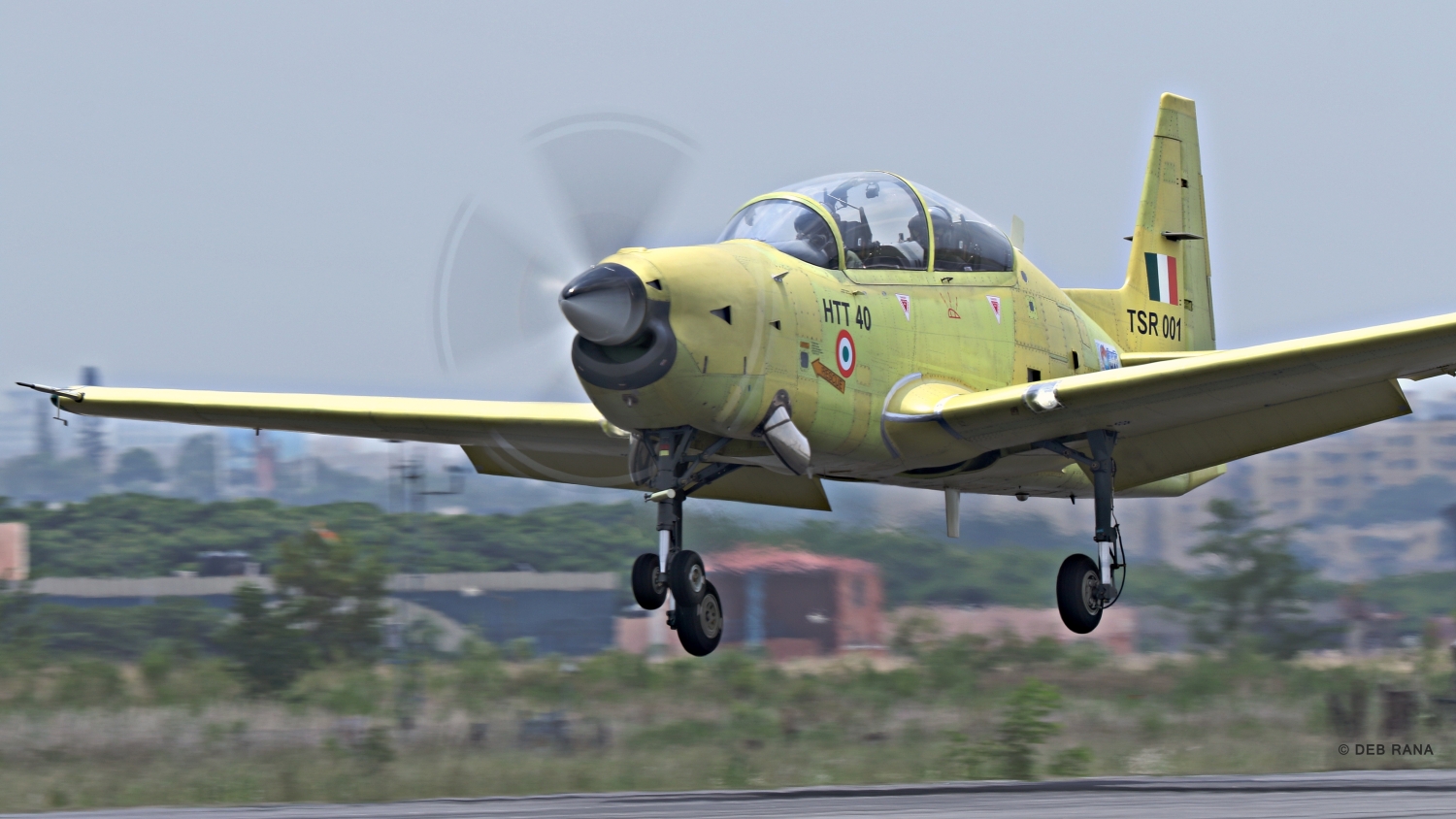
“Entering into this Manufacturing & Repair license agreement for Honeywell TPE331-12B Turboprop engine marks a major milestone in the execution of 70 HTT-40 aircraft contract with IAF. HAL is working closely with Honeywell for its support for export potential of HTT-40, he said.
HAL and Honeywell are exploring other areas such as 1MW Turbo Generators, manufacturing, Repair and Overhaul of TPE 331-10GP / 12JR engines for variants of Dornier aircraft.

 daijiworld.com
daijiworld.com
“HAL has successfully developed Basic Trainer Aircraft (HTT-40) to address the basic training requirements of the IAF. There is potential requirement of 70 aircraft. The contract for the same with IAF is under advanced stage of approval”, said Madhavan.

“We are proud of our four decade long partnership with HAL and happy to extend our relationship with this new order,” said Eric Walters, Senior Director OE Sales, Honeywell Defence and Space. The TPE331-12 family of engines has proven itself in operations all over the world, and we have committed to support and deliver engines as well as kits within the stipulated schedule to meet the requirements of the IAF.
Honeywell is committed to support export of HTT-40 aircraft in coming years along with other engine programmes which are currently on radar. This contract would pave the way for future collaboration between HAL and Honeywell, Madhavan explained.
The TPE331-12B engine is a single shaft turboprop engine with integral inlet and gearbox, two stage centrifugal compressor, power turbine, gearbox, three stage axial turbine and turbine exhaust diffuser as well as EEC for reliable power and outstanding operational characteristics. The HTT-40 prototypes are powered by TPE331-12B engines and has been serving well since 2014.
Prototype of HAL HTT-40 Basic Turboprop Trainer. The HTT-40 has completed its trials and achieved Airworthiness Certification in 2022.
“Entering into this Manufacturing & Repair license agreement for Honeywell TPE331-12B Turboprop engine marks a major milestone in the execution of 70 HTT-40 aircraft contract with IAF. HAL is working closely with Honeywell for its support for export potential of HTT-40, he said.
HAL and Honeywell are exploring other areas such as 1MW Turbo Generators, manufacturing, Repair and Overhaul of TPE 331-10GP / 12JR engines for variants of Dornier aircraft.

HAL inks US $ 100 million deal Honeywell for supply of HTT-40 Engines
From Our Special Correspondent Daijiworld Media Network Bengaluru, Jul 27: HAL signed a contract worth over US $100 million for supply and manufacture of 88 TPE331-12B engines/kits along with maintenance and support services to power the Hindustan Trainer Aircraft (HTT-40) with leading US...
From the HAL annual report:

> CATS Warrior - We all know this program by now, aimed at creating a Loyal Wingman drone along the lines of MQ-28A. Though HAL test pilot HV Thakur has stated in one of his tweets that the design of the platform has changed from the initial ones shown at expos:

> HLFT 42 - First time hearing this name, though in all likelihood this is the official designation for the LCA SpORT (Supersonic Omni-Role Trainer) concept displayed some years ago with the next gen cockpit:

> HAPS - Unclear which one they're talking about - the one being developed as part of CATS with NewSpace or the CSIR-NAL one? Probably the former considering NAL will build the latter, either way they perform similar roles, not unlike the Boeing SolarEagle or Airbus Zephyr:

> UHM - Another new name, I don't yet know if this is the official designation for the version of ALH Dhruv with folding tail & segmented main rotor (which made its first flight recently) developed for Navy's NUH requirement, or if this is a new single-engine helo, a naval version of the Air Force/Army LUH which recently got its first LSP orders?

> DBMRH - We know this, the naval version of the IMRH medium-lift helo.

@Nilgiri
> CATS Warrior - We all know this program by now, aimed at creating a Loyal Wingman drone along the lines of MQ-28A. Though HAL test pilot HV Thakur has stated in one of his tweets that the design of the platform has changed from the initial ones shown at expos:
> HLFT 42 - First time hearing this name, though in all likelihood this is the official designation for the LCA SpORT (Supersonic Omni-Role Trainer) concept displayed some years ago with the next gen cockpit:

> HAPS - Unclear which one they're talking about - the one being developed as part of CATS with NewSpace or the CSIR-NAL one? Probably the former considering NAL will build the latter, either way they perform similar roles, not unlike the Boeing SolarEagle or Airbus Zephyr:
> UHM - Another new name, I don't yet know if this is the official designation for the version of ALH Dhruv with folding tail & segmented main rotor (which made its first flight recently) developed for Navy's NUH requirement, or if this is a new single-engine helo, a naval version of the Air Force/Army LUH which recently got its first LSP orders?
> DBMRH - We know this, the naval version of the IMRH medium-lift helo.
@Nilgiri
By Girish Linganna

© Provided by The Financial ExpressImage credit: HAL
Hindustan Aeronautics Ltd (HAL) recently signed a contract with US defence major and integrated technology company- Honeywell for supplying and manufacturing 88 TPE331-12B engines that will be fitted into the Hindustan Trainer Aircraft (HTT-40). The deal, worth over $100 million, also includes maintenance and support services to power the basic trainer aircraft.
Authorities have noted that the signing of the license agreement for the Manufacturing & Repair for Honeywell TPE331-12B Turboprop engine is a significant milestone in fulfilling the contract for providing 70 HTT-40 aircraft to the Indian Air Force (IAF).
The High-performing TPE331
Honeywell’s first Turboprop engine, the TPE331 was designed for the military from scratch in 1959. The series has since grown to include 18 engine models and 106 configurations. The MNC claims to have delivered over 13,000 engines to date. Honeywell also maintains that the engine is one of “the most reliable and proven turboprop engines in the world”, with more than 122 million hours of flight time.
The TPE331-12Bs, part of the aforementioned series of powerhouses, have powered the HTT-40 since 2014. This is a single shaft turboprop engine. It possesses an integral inlet and gearbox alongside a two-stage centrifugal compressor. It also features a gearbox, a power turbine, a three-stage axial turbine, a turbine exhaust diffuser, and EEC for power and operational characteristics.
The TPE331-12B boasts a maximum power output of 950 shaft horsepower (shp) and comes equipped with a full-authority digital engine control (FADEC) system as well. The latter combines throttle, prop, and other controls into a single control, enabling pilots to realise fuel economy to an extent earlier considered impossible.
The engine allows the HTT-40 to offer pilots quick acceleration and low-fuel consumption in addition to high reliability and flexibility. The latter two empower the conduction of a wide variety of training missions. Moreover, having a reliable engine also means that HAL has room to develop a range of variants that could potentially deliver higher performance levels.
This engine is the face of HAL’s long-standing relationship with Honeywell and the potential growth story that the two plan on sketching out.
HAL-Honeywell Cooperation
Honeywell has had a presence in India since the 1930s. The company’s aerospace legacy in the country spans a period of close to five decades.
For the longest time, the development of the TPE331-12B engines was the primary focus of the collaboration that HAL and Honeywell had embarked upon. Over the years, the partnership’s scope broadened to cover the defence sector in general. This was stressed over a decade ago when officials confirmed that the two companies were developing aircraft for India’s ‘homeland security,’ which included patrolling maritime borders and observing vital installations. They had then stated that Honeywell and HAL would also indulge in manufacturing engines for smaller aircraft.
At the time of this announcement, Honeywell had already provided 225 engines for aircraft belonging to the IAF, the Indian Navy, and the Coast Guard through HAL. The company had moved on to talking about the export potential of the “made in India” TPE331 Turboprop engine- which had a worldwide market back then, too.
By 2014, the collaboration between the two companies had moved forward from this engine- the first one to be entirely manufactured in India. Honeywell’s systems and subsystems became key components onboard HAL’s other indigenous platforms, most notably the Light Combat Helicopter (LCH) and the Light Combat Aircraft (LCA). Reports also stated that the US-based MNC had licensed the Primus 500 Weather Radar to its Indian partner.
Honeywell’s top leadership, who had been vocal about the headway the company had made in the Indian defence industry, reiterated their optimism regarding the firm’s defence outlook in India, presenting this intention in light of the government’s announcement to allow 100 per cent foreign direct investment (FDI) in defence in India.
In 2016, a time when the overhaul and upgradation of military fleets occupied the centre stage in the Indian defence sector, Honeywell was quick to identify this as an opportunity to offer its avionics systems, engine and auxiliary power unit (APU) product lines.
By this time, their long association with Indian defence had already ensured “a robust and well-established business and logistical processes.” The additional advantage was that Honeywell’s work in India- from manufacturing to procurement to commercial operations- had been aligned with the make-in-India concept even before it was formally introduced as an initiative. This made it easy for the company to adapt to the road the government had decided to embark upon.
Over the years, the company has iterated its interest in the Indian defence market over and over. They have also kept up with technological advancements and sustainability trends. Now, in addition to fulfilling the local demand, HAL is also working closely with the American giant for its support for the export potential of HTT-40. The Indian PSU and Honeywell are reportedly exploring areas such as 1MW Turbo Generators and Maintenance Repair & Overhaul (MRO) of TPE331-10GP/12JR engines for variants of Dornier aircraft.
The $100 million contract is expected to pave the way for further future collaboration between the two firms.
Greater Potential
India is actively looking to become the MRO hub of Asia for military and civilian aircraft. Since Honeywell has years of expertise in the field and a strong working relationship with HAL and multiple airlines in India, it is bound to be a great asset to the country in this journey. Per past reports, work in this direction is already underway.
Moreover, it has already proven its role in India’s ambitious goal of becoming self-reliant when it comes to defence. The company has gone a step further, collaborating with HAL (amongst other Indian companies) to help with the export potential of indigenous products. There is likely to be much more development in this arena in the future. Besides engines, systems and subsystems designed for a variety of aircraft, as well as maximum efficiency-oriented practices that the company specialises in are also likely to make further headway into the Indian defence market. In light of Honeywell’s stellar past record in India, as well as how its current collaboration with HAL complements New Delhi’s self-reliance and defence export ambitions, it is safe to say that the US-based conglomerate has a bright future here.
Author is Aerospace & Defence Analyst.
Disclaimer: Views expressed are personal and do not reflect the official position or policy of Financial Express Online.
First few minutes of this feature vid, brings up how they (Bharat Forge) basically moved a whole (RUAG) production plant from Switzerland to India for artillery production....and then optimised it for local production and further innovation.
Swiss have strong defence industry that hopefully India cooperates more with time. @xenon54 et al.
fire starter
Well-known member
IIT-MADRAS DEVELOPS DIAMOND-BASED COATING TO PREVENT WEAR-AND-TEAR FOR GUN BARRELS

IIT-Madras Develops Diamond-Based Coating To Prevent Wear-And-Tear For Gun Barrels
A diamond-like carbon coating from IIT-Madras promises to make the insides of gun barrels tough and friction-free. DRDO is developing specia...
IN has always been on the forefront when it comes to inducting indigenous platforms and IA has been doing pretty good lately. IAF is in a dire state to say the least...they went from the promise of ordering 12 LCA-Mk2 squadrons a couple of years ago to 6 now. With the depleting fleet strength, MKIs being outdated unless IAF prioritizes their upgrade ... our aerial front is looking bleak since PAF has already achieved parity with us given the number of fighters we can commit to our western front
The current CAS seems like any other corrupt IAF top brass and is increasingly showcasing his love for MRFA which is of course ain't gonna happen...these schmucks should let go the thought that the current govt will give a $30bn+ contract to some foreign firm
Wait another 5 years pn will out number IN in active submarine fleet also.IN has always been on the forefront when it comes to inducting indigenous platforms and IA has been doing pretty good lately. IAF is in a dire state to say the least...they went from the promise of ordering 12 LCA-Mk2 squadrons a couple of years ago to 6 now. With the depleting fleet strength, MKIs being outdated unless IAF prioritizes their upgrade ... our aerial front is looking bleak since PAF has already achieved parity with us given the number of fighters we can commit to our western front
The current CAS seems like any other corrupt IAF top brass and is increasingly showcasing his love for MRFA which is of course ain't gonna happen...these schmucks should let go the thought that the current govt will give a $30bn+ contract to some foreign firm
Atleast IN got their priorities right lately by opting more subs over a 3rd AC and our surface fleet is pretty strong capable to tackling both China & pak. Their air arm still sucks though by relying on Mig-29s. Unless TEDBF materializes, our ACs will be white elephantsWait another 5 years pn will out number IN in active submarine fleet also.
Last edited:
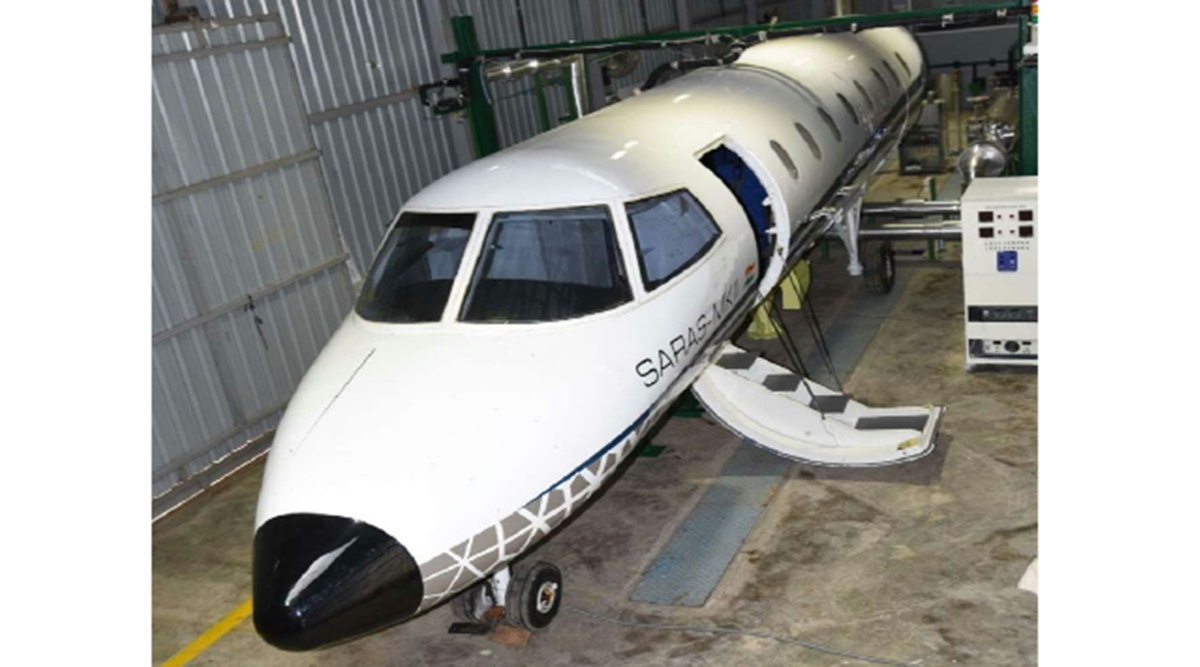
Bengaluru: 19-seater aircraft SARAS Mk II at critical design stage
The aircraft will be certified first for military use and later for civil use, according to the Council for Scientific and Industrial Research-National Aerospace Laboratories.
The Council for Scientific and Industrial Research-National Aerospace Laboratories (CSIR-NAL), which has undertaken the design, development and certification of the SARAS Mk II, said Friday that the 19-seater aircraft was at the critical design stage.
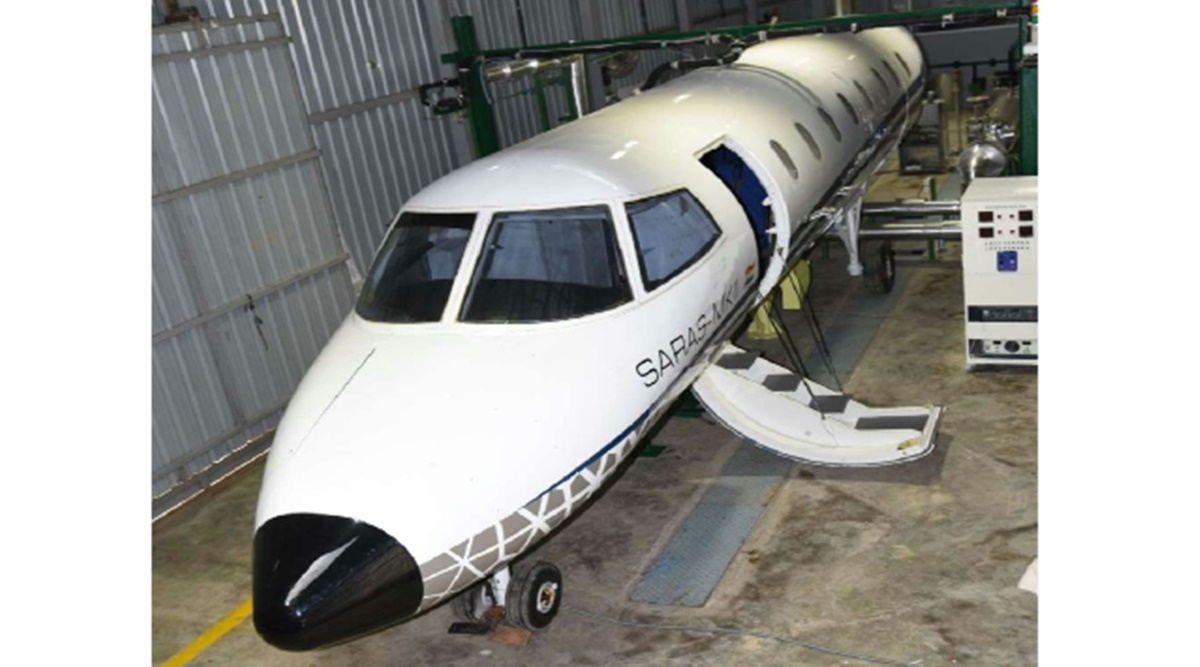
The new testing installations for Saras Mk-II aircraft. (Express Photo)
An open-air engine test bed, an aircraft environmental systems ground test and a high-fidelity, real-time flight simulator were
recently commissioned to test the various subsystems of the aircraft, the laboratory added.
Dr Abhay A Pashilkar, CSIR-NAL director, said, “The aircraft will be powered by two Pratt & Whitney PT6A-67A turboprop engines with composite propellers in the tractor configuration. The Saras-Mk II is a high-wing, twin turboprop, multi-role aircraft with passenger or troop transport, VIP transport, training and cargo shipment as primary roles. The aircraft will be initially certified by the Centre for Military Airworthiness and Certification for the military role and later by the Directorate General of Civil Aviation for the civil role.”
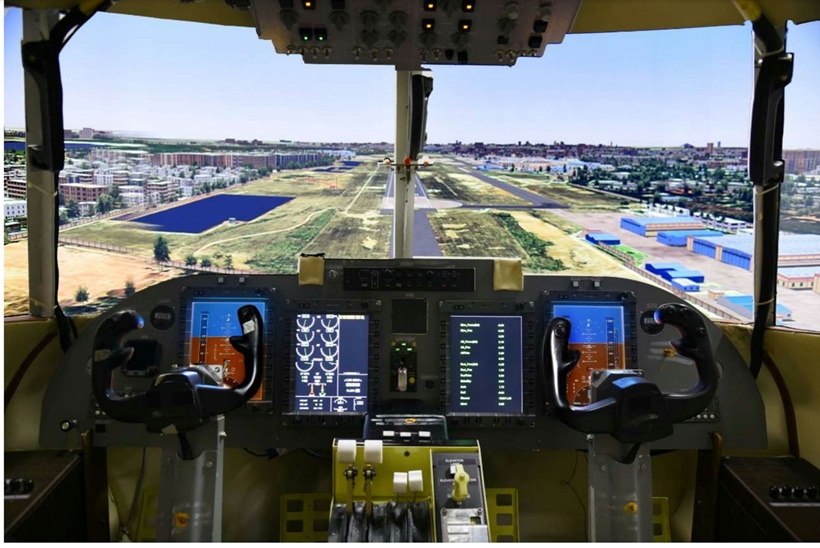
High fidelity real-time flight simulator of the Saras MK II aircraft. (Express Photo)
The open-air engine test bed has been designed, developed and established at the laboratory’s propulsion division on its Belur campus. “The test facility is equipped with all the critical line-replaceable units and subsystems such as the air-cooled oil cooling system, fuel supply system, engine control, starter generator, electrical systems required for engine ground run. During the ground run, the performance of all the subsystems is critically monitored,” Pashilkar explained.
According to Pashilkar, the aircraft environmental systems ground test facility set up to test the complete environmental control system (ECS), the pneumatic deice system, the life support system and the cabin pressure control system for the SARAS-Mk II aircraft is unique. “This is one of its kind which has the capability to check the performance of the ECS at various engine-bleed conditions at the ground level. It has a full-scale mock-up of the cabin and cockpit with all interiors, air distribution systems exactly as in the aircraft. Earlier, this kind of testing had to be done on aircraft. It was not only time-consuming, but also very expensive. With this kind of facility, both the cost and the time frame will substantially come down,” he said.
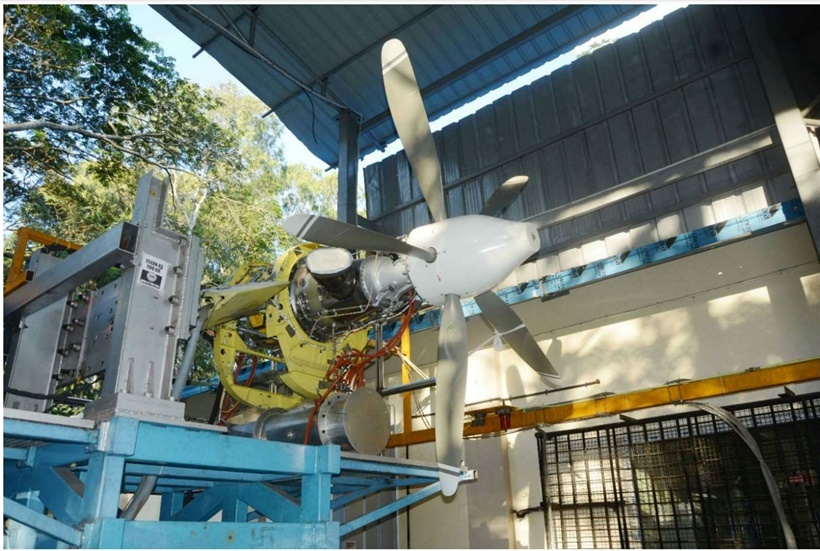
Open air engine test bed for Saras MK II aircraft. (Express Photo)
According to Pashilkar, the aircraft environmental systems ground test facility set up to test the complete environmental control system (ECS), the pneumatic deice system, the life support system and the cabin pressure control system for the SARAS-Mk II aircraft is unique. “This is one of its kind which has the capability to check the performance of the ECS at various engine-bleed conditions at the ground level. It has a full-scale mock-up of the cabin and cockpit with all interiors, air distribution systems exactly as in the aircraft. Earlier, this kind of testing had to be done on aircraft. It was not only time-consuming, but also very expensive. With this kind of facility, both the cost and the time frame will substantially come down,” he said.
The high-fidelity real-time flight simulator is meant for piloted evaluations of aircraft dynamics and testing malfunctions. “The facility can simulate all possible avionics parameters and check the functionality, reachability, vision clearance etc of all the instrument panels. The visual database is available for Bangalore, Mumbai, Lengpui, Kullu, Leh, Chandigarh, Srinagar, Pakyong and Kargil airports,” he added.
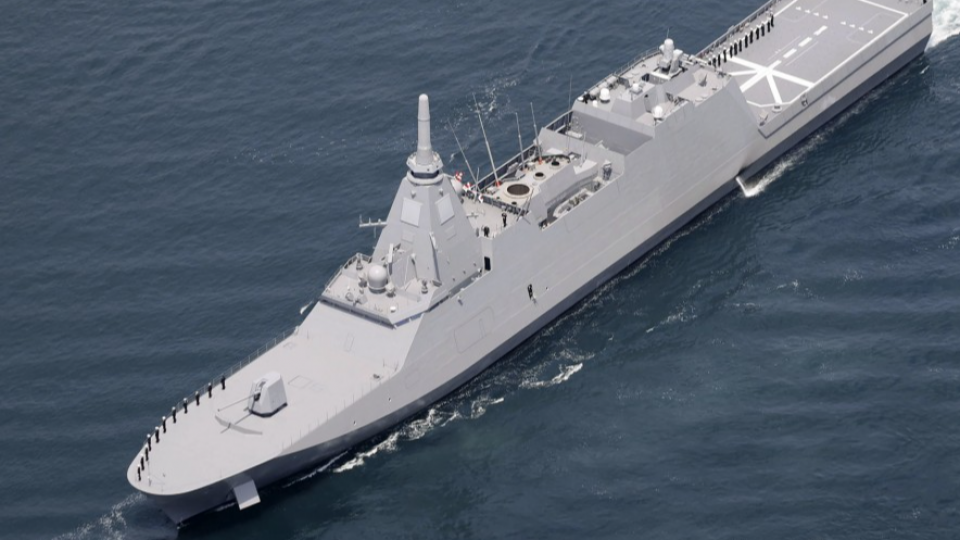
Japan to export to India stealth antennas equipped on new destroyer
Japan is planning to export to India stealth antennas equipped on a new Maritime Self-Defense Force destroyer, as the two countries strengthen security cooperation, government sources said on Oct. 15.
TOKYO - Japan is planning to export to India stealth antennas equipped on a new Maritime Self-Defense Force destroyer, as the two countries strengthen security cooperation, government sources said Saturday.
If realized, it would be the first export case under a Japan-India agreement on defense equipment and technology transfer signed in 2015.
The envisioned export is intended to prompt India to reduce its reliance on Russia in procuring military equipment and boost defense ties between Japan and India amid China's military rise, the sources said.
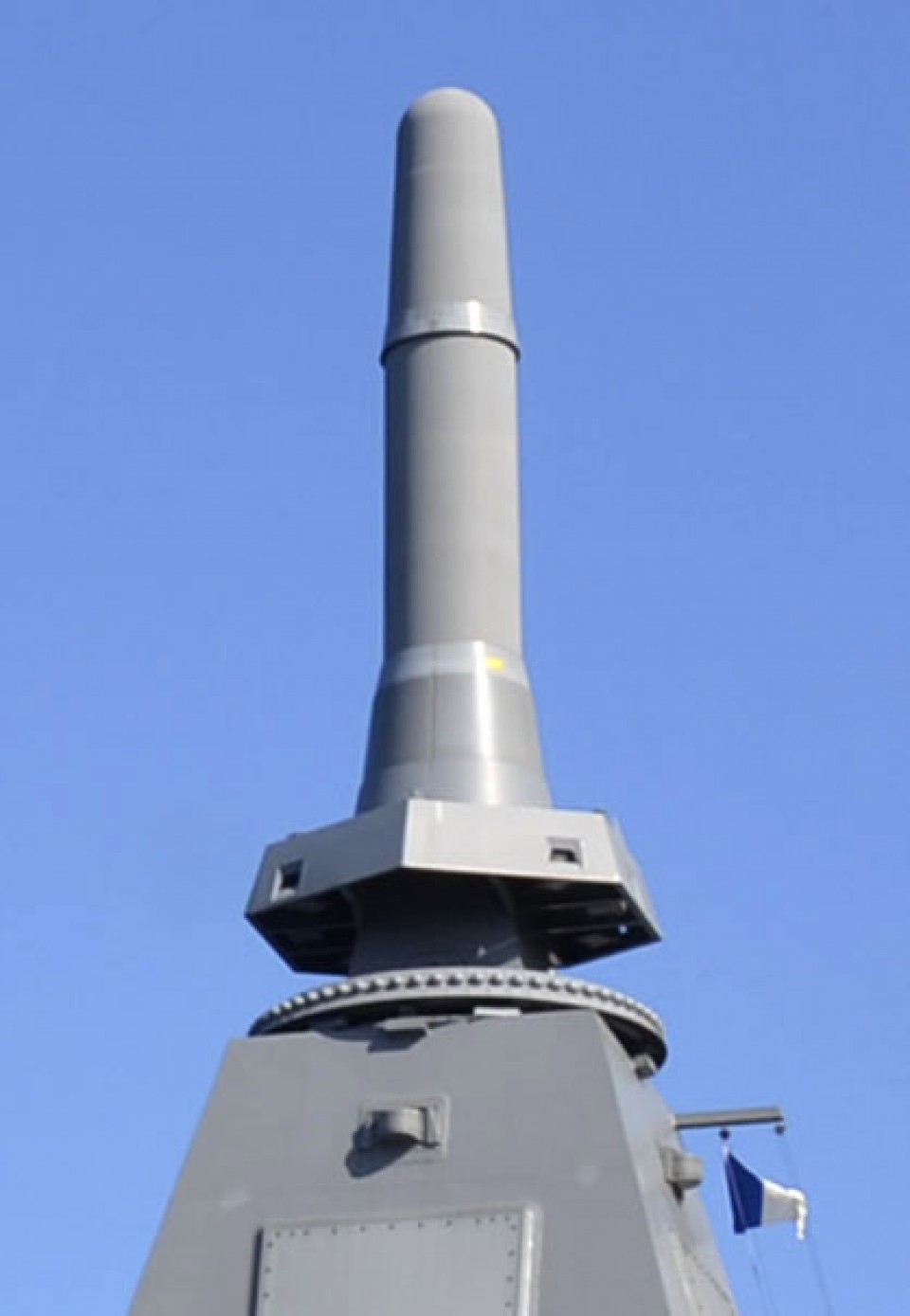
An antenna system called Unicorn seen at the Maritime Self-Defense Force's base in Yokosuka, Kanagawa Prefecture, on Sept. 5, 2022. (Kyodo)
Japan is eager to increase its defense equipment and technology exports to prop up the domestic defense industry, although it sets strict conditions due to its war-renouncing Constitution.
For instance, the three overarching principles on the transfer of defense equipment say that the transfer should not be used for offense but purposes such as surveillance and minesweeping.
Japan plans to export to India a system called Unicorn, in which numerous antennas are housed in a horn-shaped structure. It is equipped on the MSDF's new destroyer FFM commissioned in 2022.
By covering the antennas in one structure, the Unicorn system can reduce the reflection of enemy radio waves. In previous Japanese destroyers, each antenna was exposed on the mast.
Japan and India agreed to cooperate on the transfer of the Unicorn system when their foreign and defense ministers met in Tokyo in September for the so-called two-plus-two meeting, the sources said.
While Japan is concerned about China's growing maritime assertiveness, India has a long-standing border dispute with the Asian power.
Japan and India are part of the Quad, a four-way security framework that also includes Australia and the United States, with China's growing assertiveness in the Indo-Pacific region being one of their most pressing issues.
At the two-plus-two meeting, Japan told India it supports the South Asian country's efforts to diversify sources of arms procurements, the sources said.
Following the meeting, Indian Defense Minister Rajnath Singh visited the MSDF's Yokosuka base in Kanagawa Prefecture. The minister is believed to have inspected the Unicorn system mounted on the new destroyer, Kumano, and was likely briefed on its capabilities.
Aside from India, Japan has signed similar defense equipment transfer agreements with 11 countries -- the United States, Britain, France, Italy, Germany, Australia, the Philippines, Thailand, Malaysia, Indonesia and Vietnam.
The agreements came as the government led by the late former Prime Minister Shinzo Abe relaxed the rules on the transfer of defense equipment and technology in 2014 in the first major overhaul of the country's long-held arms embargo.
Japan aims to boost arms exports, but only one contract for a finished product -- air defense radars -- has been concluded with the Philippines. The slow start for such exports is partly because of high prices.
Ahead of the planned revision of the National Security Strategy, the country's long-term security and diplomatic policy guidelines, at the end of this year, the ruling Liberal Democratic Party has proposed to ease the restrictions to allow more equipment to be exported.



